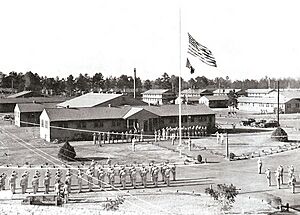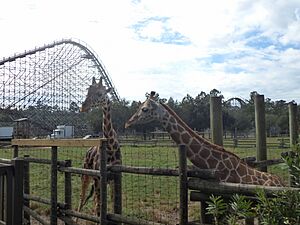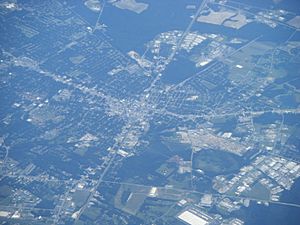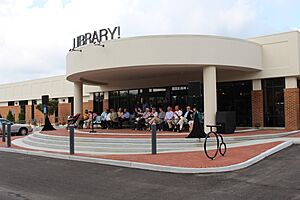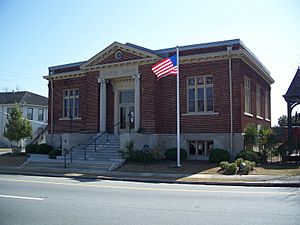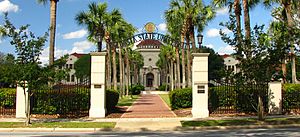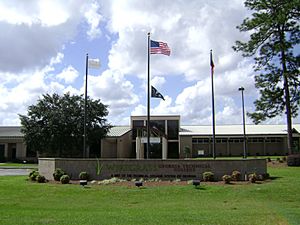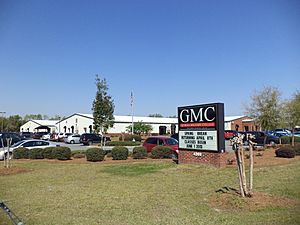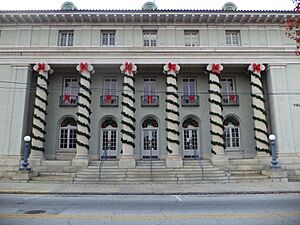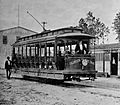Valdosta, Georgia facts for kids
Quick facts for kids
Valdosta, Georgia
|
|||
|---|---|---|---|

Valdosta Commercial Historic District
|
|||
|
|||
| Nickname(s):
Azalea City, Sportstown, Titletown USA, Winnersville
|
|||
| Motto(s):
"A City Without Limits" (2002–present)
|
|||
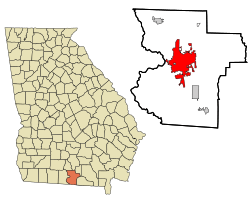
Location in Lowndes County and the state of Georgia
|
|||
| Country | United States | ||
| State | Georgia | ||
| County | Lowndes | ||
| Incorporated | December 7, 1860 | ||
| Area | |||
| • City | 36.43 sq mi (94.35 km2) | ||
| • Land | 35.99 sq mi (93.20 km2) | ||
| • Water | 0.44 sq mi (1.15 km2) | ||
| Elevation | 220 ft (67 m) | ||
| Population
(2020)
|
|||
| • City | 55,378
(14th largest) (778th in the U.S.) |
||
| • Density | 1,538.88/sq mi (594.16/km2) | ||
| • Metro | 151,118 | ||
| Time zone | UTC−05:00 (EST) | ||
| • Summer (DST) | UTC−04:00 (EDT) | ||
| ZIP Codes |
31601–31606, 31698
|
||
| Area code(s) | 229 | ||
| FIPS code | 13-78800 | ||
| GNIS feature ID | 0324649 | ||
Valdosta is a city in Lowndes County, Georgia, in the United States. It is the main city of the Valdosta metropolitan area. In 2023, this area had about 151,118 people.
The city of Valdosta itself had a population of 55,378 in 2020. Valdosta is also home to Valdosta State University. This university is part of the University System of Georgia and had over 12,000 students in 2021.
Contents
- About Valdosta
- Valdosta's Journey Through Time
- Exploring Valdosta's Landscape
- Who Lives in Valdosta?
- Valdosta's Economy and Jobs
- Fun and Culture in Valdosta
- Sports and Achievements
- Learning in Valdosta
- Valdosta in the Media
- Getting Around Valdosta
- Famous Faces from Valdosta
- Valdosta in Stories and Movies
- Images for kids
- See also
About Valdosta
What's in a Name?
Valdosta was named after a plantation owned by Governor George Troup. The plantation itself was named after the Aosta Valley in Italy. The name Aosta comes from Emperor Augustus.
Valdosta's Journey Through Time
Early Beginnings
Valdosta became an official city on December 7, 1860. It was chosen as the new county seat, taking over from nearby Troupville. The railroad was built to Valdosta that same year. This helped the new city grow quickly. Many people from Troupville moved to Valdosta when the Atlantic and Gulf Railroad arrived. The first train pulled into Valdosta in July 1860.
Growth and Change
The American Civil War began shortly after Valdosta was founded. Many men from the city served in the Confederate States Army. After the war, during the Reconstruction era, some families moved from Lowndes County to Arthington, Liberia. They were looking for new opportunities and a better life.
As time went on, Valdosta became more focused on industry. The world's second Coca-Cola bottling plant opened in Valdosta in 1897. In 1899, the cotton mill town of Remerton was built close by.
A new courthouse was built in 1904. It replaced an older, smaller building.
By 1910, Valdosta was known for its wealth, largely due to cotton. However, the boll weevil later damaged the cotton crops. Farmers then started growing tobacco and harvesting pine timber. In 1913, the South Georgia State Normal College opened. This college later grew into Valdosta State University. A streetcar system also operated in downtown Valdosta from 1899 to 1924.
Modern Valdosta Takes Shape
In 1941, Moody Army Airfield opened nearby. This was part of the United States' preparations for World War II. The city's economy got a big boost when Interstate 75 was built through the area. Many travelers heading to Florida found Valdosta a good place to stop. This highway also caused businesses to move from the old downtown area to near the Interstate.
Valdosta State College welcomed students of all races in 1963. In 1969, Valdosta High School and Pinevale High School joined together. Integration of schools had started around 1966.
In 1994, a family opened Liberty Farms Animal Park. It grew into an amusement park called Wild Adventures in 1996. A water park, Splash Island, was added in 2002. Today, Wild Adventures is a popular theme and water park.
The first automated teller machine (ATM) in Valdosta was installed at a C&S Bank in 1971.
Exploring Valdosta's Landscape
Valdosta is located in the middle of Lowndes County. It is about 15 miles north of the Florida state line. The city is about 230 miles south of Atlanta. The Withlacoochee River flows along the western edge of the city.
Valdosta's Weather
Valdosta has a humid subtropical climate. This means it has mild winters and hot, humid summers. Temperatures often go above 90 degrees Fahrenheit (32 degrees Celsius). Snow is rare, but light frosts happen between December and February. Snow fell in Valdosta most recently on January 22, 2025. As of 2023, Valdosta is in the USDA hardiness zone 9a.
Valdosta has been hit by three hurricanes within the past two years, with Helene doing considerable damage and destroying many venerable pines.
| Climate data for Valdosta, Georgia (Valdosta Regional Airport) 1991–2020 normals, extremes 1948–present | |||||||||||||
|---|---|---|---|---|---|---|---|---|---|---|---|---|---|
| Month | Jan | Feb | Mar | Apr | May | Jun | Jul | Aug | Sep | Oct | Nov | Dec | Year |
| Record high °F (°C) | 84 (29) |
88 (31) |
95 (35) |
96 (36) |
100 (38) |
106 (41) |
104 (40) |
106 (41) |
101 (38) |
96 (36) |
89 (32) |
85 (29) |
106 (41) |
| Mean maximum °F (°C) | 78.7 (25.9) |
81.5 (27.5) |
86.1 (30.1) |
89.8 (32.1) |
94.7 (34.8) |
98.0 (36.7) |
98.5 (36.9) |
98.3 (36.8) |
95.2 (35.1) |
90.0 (32.2) |
84.5 (29.2) |
80.4 (26.9) |
99.8 (37.7) |
| Mean daily maximum °F (°C) | 62.8 (17.1) |
67.0 (19.4) |
72.9 (22.7) |
79.6 (26.4) |
86.4 (30.2) |
90.1 (32.3) |
92.1 (33.4) |
91.5 (33.1) |
87.8 (31.0) |
80.5 (26.9) |
71.4 (21.9) |
65.0 (18.3) |
78.9 (26.1) |
| Daily mean °F (°C) | 50.7 (10.4) |
54.6 (12.6) |
60.1 (15.6) |
66.2 (19.0) |
73.4 (23.0) |
79.0 (26.1) |
81.1 (27.3) |
81.2 (27.3) |
77.2 (25.1) |
68.6 (20.3) |
59.0 (15.0) |
53.2 (11.8) |
67.0 (19.4) |
| Mean daily minimum °F (°C) | 38.6 (3.7) |
42.2 (5.7) |
47.2 (8.4) |
52.8 (11.6) |
60.3 (15.7) |
67.9 (19.9) |
70.1 (21.2) |
71.0 (21.7) |
66.5 (19.2) |
56.8 (13.8) |
46.6 (8.1) |
41.3 (5.2) |
55.1 (12.8) |
| Mean minimum °F (°C) | 23.6 (−4.7) |
26.7 (−2.9) |
31.3 (−0.4) |
39.2 (4.0) |
48.9 (9.4) |
61.5 (16.4) |
67.0 (19.4) |
66.0 (18.9) |
57.1 (13.9) |
40.9 (4.9) |
31.0 (−0.6) |
27.1 (−2.7) |
21.7 (−5.7) |
| Record low °F (°C) | 3 (−16) |
15 (−9) |
18 (−8) |
30 (−1) |
41 (5) |
46 (8) |
59 (15) |
59 (15) |
46 (8) |
27 (−3) |
17 (−8) |
10 (−12) |
3 (−16) |
| Average precipitation inches (mm) | 3.83 (97) |
3.31 (84) |
3.73 (95) |
3.66 (93) |
2.84 (72) |
7.08 (180) |
5.33 (135) |
5.11 (130) |
4.22 (107) |
3.71 (94) |
2.47 (63) |
3.12 (79) |
48.41 (1,230) |
| Average precipitation days (≥ 0.01 in) | 9.3 | 9.1 | 9.0 | 7.1 | 8.1 | 13.5 | 14.2 | 14.7 | 9.2 | 7.6 | 7.4 | 9.1 | 118.3 |
| Source: NOAA | |||||||||||||
Who Lives in Valdosta?
Valdosta's population has grown steadily over the years. In 1860, there were 166 people. By 2020, the city had 55,378 residents.
In 2020, the city's population was made up of different groups. About 54% were African American, and 34% were non-Hispanic white. There were also Asian, Native American, Pacific Islander, and multiracial residents. About 6% of the population was Hispanic or Latino. The average age of people in Valdosta was about 29 years old.
In 2022, there were many homes in Valdosta. Most of these homes were occupied, and many people rented their homes. The average value of a home owned by its resident was about $152,100. About 28% of the city's population lived at or below the poverty line in 2022. This included about 38% of children under 18.
Valdosta's Economy and Jobs
Valdosta is an important business center in South Georgia. It has many factories. The area around Valdosta produces tobacco, naval stores (like turpentine), and pine lumber. Valdosta is sometimes called the "Naval Stores Capital of the World." This is because it supplies a large amount of naval stores globally.
Valdosta has a major shopping mall, Valdosta Mall, with many popular stores. There are also local shops in the Historic Downtown area. The Five Points area has large stores and many restaurants. Moody Air Force Base is located about 10 miles northeast of Valdosta. Wild Adventures, a large theme and water park, is about 10 miles south of the city.
Fun and Culture in Valdosta
Libraries for Everyone
The South Georgia Regional Library has two libraries in Valdosta. These are the Valdosta Lowndes County Library and the Mae Wisenbaker McMullen Memorial Southside Library. The Valdosta Lowndes County Library is very large and holds the main offices. The Southside Library opened in 1992, thanks to a land donation. All libraries in Valdosta have been open to everyone since 1963.
Local History Museum
The Lowndes County Historical Society & Museum is in the Carnegie Library of Valdosta. This building is a historic landmark. It is one of 24 Carnegie libraries in Georgia.
Community Events Center
The Lowndes County Civic Center is a place where many community events happen. It has 120 seats and can be rented by the public. It is often used for local sports events.
Celebrating Community
The South Georgia Pride Festival is held every third Saturday in September. The first festival took place in 2008. Since 2010, the festival has grown, with over 3,000 people attending.
Sports and Achievements
Baseball History
Valdosta has been home to several minor league baseball teams. The Valdosta Stars played in 1906. From 1946 to 1958, the Valdosta Tigers were a minor league team. Valdosta also had the Valdosta Trojans, a team linked to the Brooklyn Dodgers.
"Titletown USA"
In 2008, ESPN held a contest called "Titletown USA." Fans nominated cities based on their sports championships. Valdosta was chosen as a finalist. This was because of the many championships won by teams from Valdosta High School, Valdosta State University, Lowndes High School, and other local schools.
On July 28, 2008, Valdosta was named "Titletown USA." It won with 29.2% of the fan votes. The football team at Valdosta High School has more wins than almost any other high school team in the United States.
Learning in Valdosta
Public Schools
The Valdosta City School District serves students from pre-school through twelfth grade. It has five elementary schools, two middle schools, and one high school (Valdosta High School). In 2022, the district had over 8,294 students.
The Lowndes County School District serves areas outside Valdosta city limits. It has seven elementary schools, three middle schools, and one high school (Lowndes High School). This district had 10,728 students in 2022.
Scintilla Charter Academy is a free public school. It is open to students in Lowndes County or Valdosta. It teaches grades kindergarten through ninth grade.
Private Schools
Valwood School is a private school north of Valdosta. It prepares students for college, from pre-kindergarten to twelfth grade. Several Christian schools also operate in the area. These include Crossroads Baptist School, Georgia Christian School, and St. John Catholic School.
Colleges and Universities
Valdosta is home to Valdosta State University (VSU). It started in 1906 as a college for women. It became part of the University System of Georgia in 1950. VSU gained university status in 1993.
An extension of Georgia Military College is also in the city. Wiregrass Georgia Technical College is located just outside the city limits. Embry-Riddle Aeronautical University-Worldwide: Moody Campus is also in Valdosta.
Valdosta in the Media
Local News and Radio
The local newspaper is The Valdosta Daily Times. Valdosta also has many radio stations. These stations play different types of music and talk shows. Some examples include WJEM (Gospel), WVLD (Rock), and WDDQ (Talk radio).
Television Channels
Valdosta receives television channels from the Tallahassee, Florida area. It also gets some channels from the nearby Albany market. WSWG channel 44 is the local CBS channel. WXGA-TV channel 8 is the local GPB station.
Getting Around Valdosta
Main Roads and Highways
 Interstate 75 runs north to south through Valdosta. It connects the city to places like Tifton to the north and Lake City, Florida to the south.
Interstate 75 runs north to south through Valdosta. It connects the city to places like Tifton to the north and Lake City, Florida to the south. U.S. Highway 41 runs north to south through the city.
U.S. Highway 41 runs north to south through the city. U.S. Highway 84 runs west to east through Valdosta. It connects to Waycross in the northeast and Thomasville in the west.
U.S. Highway 84 runs west to east through Valdosta. It connects to Waycross in the northeast and Thomasville in the west. U.S. Highway 221 also passes through the area.
U.S. Highway 221 also passes through the area.
Other Ways to Travel
The Valdosta Regional Airport is located south of the city. It offers flights to Hartsfield–Jackson Atlanta International Airport. There is also a Greyhound bus station for bus travel.
For walking and biking, Valdosta has the Azalea City Trail and the VSU Walking Trail System.
Valdosta used to have a streetcar system. It operated in the downtown area from 1899 to 1924. The tracks were removed in the 1940s.
Passenger trains used to stop in Valdosta. Trains like the South Wind and the Ponce de Leon connected Valdosta to other major cities. However, passenger train service to South Georgia ended in 1979.
Famous Faces from Valdosta
Many notable people have connections to Valdosta:
- Rhett Akins, a country music artist.
- Bill Hicks, a famous comedian.
- Pauley Perrette, an actress known for NCIS.
- Billy Joe Royal, a country and pop music artist.
- Sonny Shroyer, an actor from The Dukes of Hazzard.
- Demond Wilson, an actor from Sanford and Son.
- Doc Holliday, a well-known Western figure, spent his youth here.
- James Lord Pierpont, who composed "Jingle Bells," lived and taught music in Valdosta.
- Allen Boyd, a former U.S. Representative from Florida.
- Charlie Norwood, a former U.S. Congressman from Georgia.
- Buck Belue, a former University of Georgia quarterback.
- Lorenzo Cain, a professional baseball player.
- Harris English, a professional golfer.
- Malcolm Mitchell, a former NFL wide receiver.
- Kenny Moore II, an NFL player.
- Jay Ratliff, a former NFL nose tackle.
- Telvin Smith, a former NFL linebacker.
Valdosta in Stories and Movies
Valdosta has been featured in several books and films:
- Parts of the novel Fried Green Tomatoes at the Whistle Stop Cafe and its movie are set in Valdosta.
- Scenes from the movie Zombieland were filmed on Valdosta streets and at Wild Adventures.
- The 1986 movie As Summers Die was filmed in Valdosta.
- In John Steinbeck's novel East of Eden, a character stops in Valdosta.
Images for kids
See also
 In Spanish: Valdosta para niños
In Spanish: Valdosta para niños




